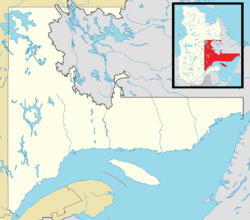Fermont | |
|---|---|
| Ville de Fermont | |
 | |
| Motto(s): Faire front, faire face | |
| Coordinates: 52°47′N 67°05′W / 52.783°N 67.083°W[1] | |
| Country | Canada |
| Province | Quebec |
| Region | Côte-Nord |
| RCM | Caniapiscau |
| Settled | 1971 |
| Constituted | October 15, 1974 |
| Government | |
| • Mayor | Martin St-Laurent |
| • Federal riding | Manicouagan |
| • Prov. riding | Duplessis |
| Area | |
| • Total | 503.06 km2 (194.23 sq mi) |
| • Land | 451.12 km2 (174.18 sq mi) |
| • Urban | 1.45 km2 (0.56 sq mi) |
| Elevation | 610 m (2,000 ft) |
| Population | |
| • Total | 2,256 |
| • Density | 5.0/km2 (13/sq mi) |
| • Urban | 2,151 |
| • Urban density | 1,484.0/km2 (3,844/sq mi) |
| • Pop (2016-21) | |
| • Dwellings | 1,538 |
| Time zone | UTC−5 (EST) |
| • Summer (DST) | UTC−4 (EDT) |
| Postal code(s) | |
| Area code(s) | 418 and 581 |
| Highways | |
| Website | www |
Fermont (/ˈfɛərmɒnt/)[5] is a mining city in Côte-Nord region, Quebec, Canada, near the Quebec-Labrador border about 23 kilometres (14 mi) from Labrador City on Route 389, which connects to the Trans-Labrador Highway (Newfoundland and Labrador Route 500). It is the seat of the Regional County Municipality of Caniapiscau.
Fermont (French contraction of "Fer Mont", meaning "Iron Mountain") was founded as a company town in the early 1970s to exploit rich iron ore deposits from Mont Wright, which is about 25 kilometres (16 mi) to the west.
The town is notable for the huge self-contained structure containing apartments, stores, schools, bars, a hotel, restaurants, a supermarket and swimming pool; the large building shelters a community of smaller apartment buildings and homes on its leeward side. Popularly known as The Wall (Le Mur), the structure was designed to be a windscreen to the rest of the town. It permits residents (other than mine workers) to never leave the building during the long winter, which usually lasts about seven months. The town, designed by Maurice Desnoyers and Norbert Schoenauer, was inspired by similar projects in Sweden designed by Ralph Erskine, notably that of Svappavaara, an iron mining town in Sweden. The building measures 1.3 kilometres (4,300 ft) long [6] and stands 15 metres (49 ft) high.[7]
- ^ Cite error: The named reference
toponymiewas invoked but never defined (see the help page). - ^ a b "Répertoire des municipalités: Geographic code 97035". www.mamh.gouv.qc.ca (in French). Ministère des Affaires municipales et de l'Habitation. Retrieved 2024-04-30.
- ^ a b "Fermont (Code 2497035) Census Profile". 2021 census. Government of Canada - Statistics Canada. Retrieved 2024-04-30.
- ^ a b "Fermont, Quebec [Population centre] Census Profile". 2021 Census of Population. Government of Canada - Statistics Canada. 9 February 2022. Retrieved 2024-04-30.
- ^ The Canadian Press (2017), The Canadian Press Stylebook (18th ed.), Toronto: The Canadian Press
- ^ "The Windscreen (from Caniapiscau)". Archived from the original on 2006-04-21. Retrieved 2006-06-24.
- ^ "Mur-écran - Mcr de Caniapiscau". Archived from the original on 2022-02-19. Retrieved 2022-02-19.


